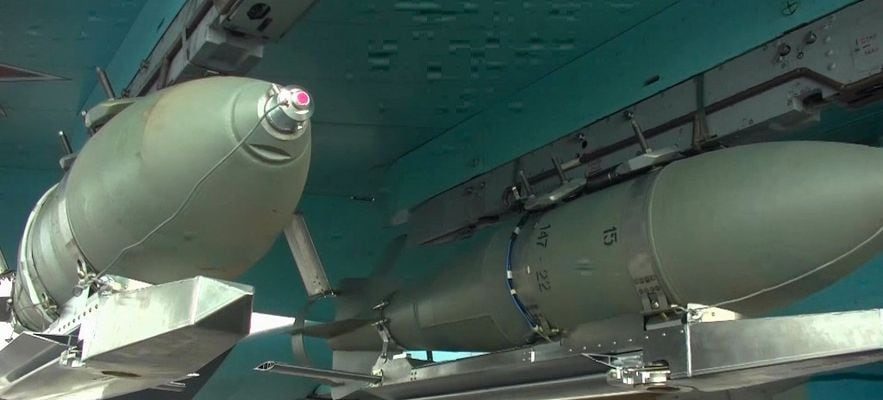After a huge explosion, a large plume of black smoke rose into the air above the fortified town of Vouhledar in early April. A few moments earlier, a Russian gliding bomb hit head-on this ruined city, fiercely defended by the Ukrainians for more than two years. Very destructive, these bombs have seen their use explode in recent months on the Ukrainian front. About fifty kilometers to the northeast, in Avdiivka, more than sixty fell daily at the height of the battle, before kyiv’s forces decided to leave the city in mid-February in the face of the threat of ‘an encirclement.
This flood of fire is here to stay. According to the Ukrainian general staff, the Russian army has already dropped more than 3,500 of these bombs since the start of the year, sixteen times more than in 2023. Moscow has the advantage of having stock. “Originally, these are basic bombs dating from the Soviet era, which Russia has in very large numbers,” explains Mykhailo Gonchar, president of the Ukrainian institute Center for Global Studies Strategy XXI. But the current models have been modernized by the addition of wings and a guidance module, in order to gain range and precision.” A system known as UMPK, attached to the bomb.
Thanks to this development, Russian pilots are no longer forced to drop them vertically above their target – like the bombers of the Second World War – but can fire at long distances, without risking being hit. be shot down by Ukrainian anti-aircraft defenses. “The range of these bombs is now 50 to 70 kilometers,” notes Mykhailo Gonchar. “Russian planes can therefore generally stay out of the range of our surface-to-air missile batteries.” Unless, for kyiv, it brings its few systems closer to the front line and puts them at increased risk of destruction.
Large caliber bombs
Moscow’s forces have already been able to upgrade a whole range of large-caliber bombs, such as the FAB-250 (250 kilos), the FAB-500 (500 kilos) or the FAB-1500 (1.5 tonne). For ever more devastating strikes. “The FAB-1500 contains 675 kilos of explosives, notes Jean-Christophe Noël, former air force officer and associated researcher at the French Institute of International Relations (Ifri). These bombs are particularly suited to come strike large fixed targets, such as a command post, bunker or ammunition depot.”
A Russian Su-34 bomber equipped with FAB-500 bombs fitted with a UMPK kit, in the south of the Donetsk region, March 18, 2024.
© / Anadolu via AFP
Enough to increase the pressure on the Ukrainian forces, at a time when kyiv is urgently building a network of 2,000 kilometers of fortifications on the front, facing fears of an intensification of Russian assaults this summer. “The enemy has considerably increased the activity of its aircraft, using KAB [NDLR : bombes dotées d’un système UMPK], guided aerial bombs which destroy our positions”, conceded at the end of March the commander-in-chief of the Ukrainian armies, Oleksandr Syrsky. Ultimately, could they break the defense lines put in place by kyiv? “They will not be enough for them alone, but the Russians will probably use it to try to weaken them, judges Xavier Tytelman, former military aviator and aeronautical expert. It will be another tool to try to break through locally.”
Especially since beyond their destructive power, these bombs benefit from a significant advantage: their price. “Unlike a missile filled with electronics, they are not very expensive,” adds Jean-Christophe Noël, of Ifri. “The kit to transform the bomb is relatively simple to manufacture.” For comparison, the Joint Direct Attack Munitions (JDAM) kits of the American army – also allowing the transformation of simple bombs (so-called smooth bombs) into glide bombs, and some of which were delivered to kyiv from March 2023 – are estimated at 21,000 dollars per unit, compared to 1.5 million for an ATACMS missile.
Difficult to detect
A real scourge, these flying bombs are also difficult to detect and intercept, “to the extent that they are not propelled and do not emit heat, underlines Xavier Tytelman. This requires heavy systems equipped with radar – including the Ukrainians are missing on the front.” The whole challenge for the Ukrainian forces is to succeed in destroying the planes which drop them. One of the reasons behind Volodymyr Zelensky’s repeated calls for increased deliveries of long-range air defenses. “I won’t tell you how many Patriot systems we have. I can say that to completely cover Ukraine in the future, it is better to have 25 Patriot systems, with 6 to 8 batteries each,” he insisted. the Ukrainian president, April 6, on television.
Beyond that, the F-16 planes promised by several European countries – expected in Ukraine this summer – could also prove to be of precious help. “Thanks to their long-range air-to-air missiles, which we have requested from our European and American partners, they could reduce the activity of the Russian air forces,” confirms Mykhailo Gonchar. In the meantime, Ukrainians make do with what they have. On April 5, kyiv announced that it had destroyed six Russian aircraft and severely damaged eight others at the Russian air base in Morozovsk, thanks to massive drone strikes. However, the threat will not disappear anytime soon. In March, Russian Defense Minister Sergei Shoigu announced “mass production” of FAB-3000 bombs, capable of carrying up to 1,400 kilos of explosives…
.
